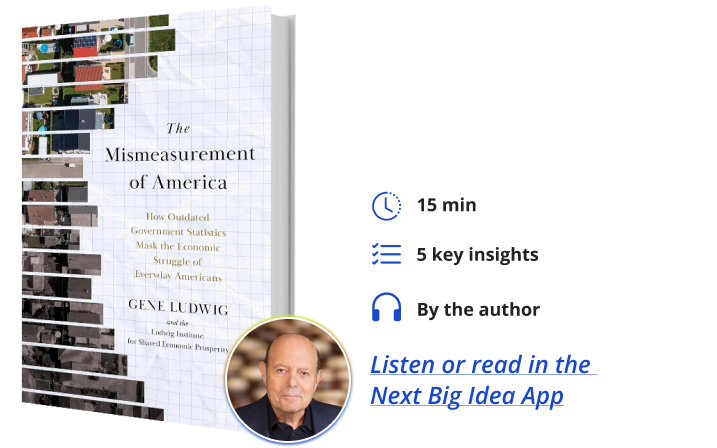Below, Gene Ludwig shares five key insights from his new book, The Mismeasurement of America: How Outdated Government Statistics Mask the Economic Struggle of Everyday Americans.
Gene is the former Comptroller of the Currency and founder of the Ludwig Institute for Shared Economic Prosperity (LISEP), a nonprofit dedicated to uncovering the truths that official statistics too often obscure. His writing has appeared in The New York Times, The Wall Street Journal, The Atlantic, Politico, The Financial Times, and TIME.
What’s the big idea?
Americans keep hearing that the economy is strong. Unemployment is low. Wages are rising. Growth is steady. But for millions of families, those headlines feel like a cruel joke. The cost of rent, groceries, and healthcare keep climbing while steady, well-paid work remains out of reach. The disconnect isn’t just perception—it’s baked into the way we measure economic success.

1. We are at an economic tipping point.
Throughout history, when governments fail to fully appreciate the realities faced by their people, it leads to crisis. The United States may be on the brink of such economic and societal unrest. The unrest that led to the French Revolution and the economic imbalances preceding the Great Depression are both cases in point.
In the late eighteenth century, the oppressive economic situation facing the French people went unacknowledged by the royal family for decades. The French ruling class considered the truth about the nation’s fiscal crisis to be nefarious—a threat to their power. Marie Antoinette, when told the peasants had no bread, replied, “Let them eat cake!” Whether or not the remark is literal or legend, it captures the ruling class’s indifference. Soon after, the Revolution erupted, bringing turmoil and suffering to French citizens of every rank and station.
The same narrative arc applied a century and a half later when the Great Depression loomed. In both instances, economic data that could have set off alarm bells was available—more accurate figures that would have revealed the risks emerging—and this perspective might have prompted action that could have softened the blow, if not avoided the crises altogether. But the data was either confusing, confounded with other contrary data, or affirmatively hidden. The effects were catastrophic.
2. A quarter of Americans are functionally unemployed.
The unemployment statistics our government releases monthly are misleading. If someone is looking for full-time employment but finds nothing except a single hour of work in a week, they are considered “employed” in the eyes of the government. For purposes of official government statistics, this one-hour employee is in the same category as someone secure in a full-time job.
This logic extends to wages. Someone who works full- or part-time for a salary that falls below the poverty line (around $25,000 a year for a three-person household) is classified the same way as someone earning $1 million every month.
“The United States may be on the brink of such economic and societal unrest.”
LISEP’s research team and I consider anyone in the previous two situations to be functionally unemployed. The government’s most recent unemployment rate is 4.3 percent, but our research finds that 24.7 percent of American workers are functionally unemployed.
3. Pay statistics ignore part-time and unemployed job seekers.
The government reports on “median wages” every quarter. The idea behind their metric is simple and straightforward: If you line up all full-time employees in order of their weekly earnings, the person directly in the middle earns the median wage.
But this statistic only considers the wages of people who are currently employed full-time, overlooking millions of part-time workers and unemployed job seekers. So, the moment a low-wage factory worker receives a pink slip, her salary is deleted from the sample altogether. The moment a farm worker’s seasonal employment ends, his salary is similarly deleted.
What this means is the official earnings measure shows an overstated wage that doesn’t reflect the reality for many low- and middle-income Americans. It can even appear to improve during economic downturns because low-wage workers are disproportionately affected by layoffs. When the economy went into near freefall during the early months of the COVID-19 pandemic, government-reported median earnings rose seven percent. During that same period, the percentage of functionally unemployed Americans rose from 25.7 percent to 32.8 percent.
4. Yes, your groceries are more expensive.
When people talk about inflation, they’re usually referring to changes in the Consumer Price Index, or CPI. The CPI tracks the prices of some 80,000 goods and services, from apples to apartments, baby formula to boats, and much more. The idea is that it gives us a single figure to measure the changing cost of a basket of all consumer products.
“CPI obscures the true cost of living for working-class Americans.”
This basket is so wide-ranging that it doesn’t reflect how “ordinary” consumers experience cost-of-living changes, as most Americans are not buying 80,000 things. If the costs of second homes tripled while everything else in the basket stayed flat, the average American household wouldn’t feel a thing—the price hike would get averaged in, but it wouldn’t impact their life.
But the opposite is true. Over the past two decades, the price of jewelry has risen by about 39 percent, while essential goods like bread are up by 112 percent and ground beef by 155 percent. When these items are measured alongside each other in the CPI, the relative stability of luxury items masks the inflation faced by Americans of more modest means. From 2001 to 2023, the CPI points to a 72 percent rise in living costs, yet our analysis of essential expenses—housing, food, transportation, healthcare, and other basics—shows those costs climbed 97 percent. CPI obscures the true cost of living for working-class Americans.
5. We need better statistics.
The headline statistics we currently employ to understand America’s economy are profoundly misleading and, unfortunately, drive policy. The CPI is pivotal in determining Social Security Benefits, as well as who qualifies for the Supplemental Nutrition Assistance Program, Head Start, and Pell Grants. At least twelve states and Washington, D.C., used the CPI to determine minimum wage.
Our failure to produce statistics that accurately reflect the nation’s economic reality makes it much harder to shape highly effective policy responses—and harder to identify the tipping point of economic and social unrest. Simply put, when you aim at the wrong target, you miss.
“Human nature favors expeditious, rosy analysis rather than the rigor required to glean accuracy.”
Flaws in widely accepted economic statistics impede important decision-making. In many cases, those who accept economic misrepresentations do so for benign reasons: The data is too difficult to collect with sufficient regularity or precision, or the samples aren’t sufficiently comprehensive. Human nature favors expeditious, rosy analysis rather than the rigor required to glean accuracy, particularly when accurate numbers may be gloomy.
At LISEP, we’ve developed alternatives to these imperfect statistics. Our True Rate of Unemployment metric includes the functionally unemployed, and our True Weekly Earnings measure includes the entire workforce. Our True Living Cost index narrows the basket of indexed consumer goods to those truly essential to the average American, while our Minimal Quality of Life index measures what it costs to not just get by but to actually have an opportunity to climb the economic ladder. Finally, our Shared Economic Prosperity measure tracks how the country’s economic growth translates into opportunity for all.
For decades, policymakers and leaders have judged success or failure by distorted standards, and ordinary Americans have paid the price. Unless we change the headline statistics to reflect the reality Americans actually feel, we will keep steering down the wrong paths.
Enjoy our full library of Book Bites—read by the authors!—in the Next Big Idea App:





























